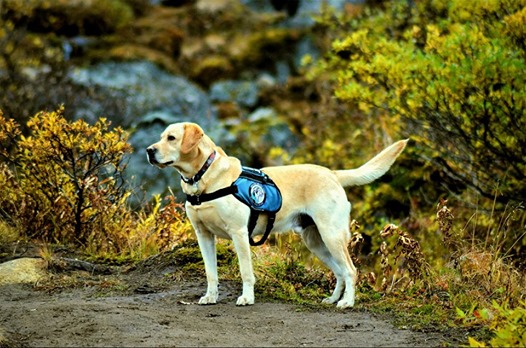For many Alaskans, staying active and independent is not just about lifestyle preferences, it is a necessity. Harsh winters, rugged terrain, and long distances between communities can make mobility challenges more difficult to manage. Mobility assistance dogs are trained to bridge that gap, providing their partners with practical support, increased safety, and greater freedom. At Alaska Dog Works, through our Lead Dog Service Dog Training program, we have helped countless clients regain confidence, improve daily living, and embrace a more active lifestyle with the help of a highly trained service dog.
This guide will walk you through what mobility assistance dogs can do, who can benefit from their skills, and how our program supports Alaskans in building life-changing partnerships.
What is a Mobility Assistance Dog?
A mobility assistance dog is a highly trained service dog that helps people with physical disabilities or mobility impairments perform essential daily tasks. These dogs are not just pets, they are working partners trained to meet the unique needs of their handlers. Their skills range from retrieving dropped items to providing balance and stability while walking.
Unlike general obedience-trained dogs, mobility assistance dogs undergo months or even years of specialized training to ensure they can perform their duties reliably in any situation. This includes work in public settings, where they must remain calm and attentive regardless of distractions.
Why Mobility Assistance Dogs Are Especially Important in Alaska
Living in Alaska presents unique challenges for individuals with mobility impairments. Uneven terrain, icy walkways, and extreme temperatures can increase the risk of falls and limit outdoor activities. Public spaces may also be more spread out, requiring greater endurance and stability to navigate.
In these environments, a mobility assistance dog is more than just helpful, they can be a lifeline. Whether guiding their partner safely over a frozen sidewalk in Anchorage, helping navigate a gravel path in the Mat-Su Valley, or assisting with daily errands in Fairbanks, these dogs make independence possible where it might otherwise feel out of reach.
Who Can Benefit from a Mobility Assistance Dog?
Mobility assistance dogs can assist people with a wide range of conditions, including:
Spinal cord injuries
Multiple sclerosis (MS)
Cerebral palsy
Muscular dystrophy
Parkinson’s disease
Balance disorders
Arthritis or joint degeneration
Post-stroke mobility impairments
In our Lead Dog Service Dog Training program, we have worked with clients who needed help with everything from daily household tasks to navigating challenging outdoor environments. Many of our Alaska-based clients also deal with seasonal conditions that increase mobility risks, making the consistent support of a service dog invaluable.
What Mobility Assistance Dogs Can Do
The specific skills of a mobility assistance dog are tailored to the individual’s needs. Below are some of the most common tasks they perform for their handlers:
1. Balance and Stability
Mobility assistance dogs can provide physical support to help their handler stay steady while walking or standing. They may wear a specially designed harness with a rigid handle that allows the handler to hold on for stability.
2. Retrieving Items
From dropped keys to out-of-reach phones, a mobility assistance dog can retrieve items without the handler needing to bend or strain.
3. Opening and Closing Doors
Dogs trained in door-handling can open standard and automatic doors, a valuable skill when navigating public spaces.
4. Pulling a Wheelchair
For individuals who use a manual wheelchair, a mobility assistance dog can be trained to provide momentum when moving over longer distances or challenging surfaces.
5. Helping with Transfers
Some dogs can help their handler move from one position to another, such as from a wheelchair to a bed or chair, by providing stability and counterbalance.
6. Pressing Buttons
Whether it is an elevator button, automatic door switch, or pedestrian crossing signal, mobility assistance dogs can be trained to use their nose or paw to activate them.
7. Emergency Assistance
If a handler falls or is in distress, a trained service dog can fetch help, retrieve a phone, or activate an alert system.
8. Carrying Items
Dogs can carry small bags or items in a specially designed backpack or pouch, freeing up their handler’s hands.
The Training Behind the Skills
At Alaska Dog Works, our Lead Dog Service Dog Training program is built on over 20 years of experience in training service dogs to meet rigorous standards. Our process for mobility assistance dogs is extensive and individualized.
Key stages in our training include:
Evaluation of the Client’s Needs
Before we begin training, we spend time understanding the handler’s physical abilities, daily routines, and specific challenges.Foundational Obedience and Public Access Skills
Every service dog must be impeccably behaved in public, responding consistently to commands and ignoring distractions.Task-Specific Training
We focus on the precise skills that will best serve the handler, whether that is retrieving items, providing stability, or assisting with transfers.Environmental Conditioning
Dogs are exposed to various settings they may encounter in Alaska, icy sidewalks, busy grocery stores, hiking trails: so they are confident and adaptable.Team Training
The handler learns how to work with their service dog, ensuring clear communication and mutual trust.
Success Stories from Alaska
We have seen firsthand how mobility assistance dogs change lives.
One of our clients in Juneau, living with cerebral palsy, is highly active with his service dog. Another client in Anchorage, recovering from a spinal cord injury, regained the confidence to attend community events knowing his service dog could provide balance support and pick up dropped items without strain.
These are not isolated cases, our program is designed to create lasting, life-changing results for our clients across Alaska and beyond.
The Difference Between a Mobility Assistance Dog and an Emotional Support Animal
It is important to understand that a mobility assistance dog is a legally recognized service dog under the Americans with Disabilities Act (ADA). This means they have public access rights that emotional support animals do not. Their training is focused on performing specific tasks directly related to their handler’s disability.
While emotional support animals provide comfort and companionship, they are not trained for task-specific work and do not have the same legal protections.
Maintaining a Mobility Assistance Dog’s Skills
Once a mobility assistance dog is placed with their handler, ongoing training is essential. At Alaska Dog Works, we offer follow-up support and refresher training to ensure the dog’s skills remain sharp. This includes adjusting tasks as the handler’s needs evolve.
Regular practice, consistent routines, and positive reinforcement all contribute to keeping a service dog reliable in their work.
How to Get Started with the Lead Dog Service Dog Training Program
The process begins with a consultation to determine if a mobility assistance dog is right for you. Not every dog is suited for service work, and not every person’s lifestyle is compatible with having a service dog. Our goal is to make sure the partnership is the right fit for both handler and dog.
We work with clients throughout Alaska and can also place dogs with clients in other states. However, our focus is on serving the unique needs of Alaskans, where conditions and environments often require extra preparation and specialized training.
The Impact on Independence and Quality of Life
The benefits of having a mobility assistance dog go beyond the physical tasks they perform. Many of our clients report feeling:
More confident in public spaces
More willing to engage in community activities
Less dependent on friends or family for assistance
More active in both indoor and outdoor environments
These outcomes are the result of having a partner who is dependable, skilled, and always by your side.
Common Myths About Mobility Assistance Dogs
Myth 1: They Are Only for People in Wheelchairs
While wheelchair users can benefit greatly, mobility assistance dogs also serve those with balance issues, muscle weakness, or chronic pain.
Myth 2: Any Dog Can Be a Mobility Assistance Dog
Only dogs with the right temperament, health, and trainability can succeed in this demanding role.
Myth 3: Once Trained, They Do Not Need Maintenance
Service dogs require ongoing reinforcement and handler engagement to maintain their skills.
Your Partner in Independence
At Alaska Dog Works, we believe in the power of partnership between a person and their service dog. Our Lead Dog Service Dog Training program is designed to give Alaskans the tools, skills, and confidence they need to live life on their own terms. Whether navigating an icy sidewalk, retrieving dropped items, or offering steady support on a hiking trail, a mobility assistance dog can be the key to unlocking greater independence.
If you or someone you know could benefit from a mobility assistance dog, the first step is a conversation. Contact Alaska Dog Works today to schedule a strategy call and learn more about our Lead Dog Service Dog Training program. Together, we can help you take the next step toward independence and an active, fulfilling life.
We offer a FREE Strategy Call.
Click on the graphic to learn more
Read More


Canadian Eskimo Dog: A Storied Arctic Sled Dog of Resilience, History, and Care








